Physical Address
304 North Cardinal St.
Dorchester Center, MA 02124
Although previously grouped together in this textbook, superficial and deep fibromatoses are now discussed separately because of distinct differences in clinical behavior. The superficial fibromatoses are described with the benign fibroblastic/myofibroblastic proliferations (see Chapter 7 ). Deep fibromatoses are included in this chapter, which focuses on fibroblastic/myofibroblastic tumors of borderline and malignant behavior. This chapter also describes congenital/infantile fibrosarcoma and inflammatory myofibroblastic tumor (previously discussed with fibrous tumors of infancy and childhood; see Chapter 8 ), because these entities are better considered variants of fibrosarcoma with borderline clinical features.
The deep fibromatoses, whether arising from the abdominal wall, mesentery, or other, extraabdominal locations, share overlapping clinical, morphologic, immunohistochemical (IHC), and molecular genetic features, although certain attributes are unique to each. This section discusses the features shared by the deep fibromatoses as well as features that distinguish these entities from one another.
Extraabdominal fibromatosis arises principally from the connective tissue of muscle and the overlying fascia or aponeurosis ( musculoaponeurotic fibromatosis ); it chiefly affects the muscles of the shoulder, pelvic girdle, and thigh of adolescents and young adults. Other terms used to describe this condition include extraabdominal desmoid, desmoid tumor, and aggressive fibromatosis .
Abdominal fibromatosis occurs in young, gravid, or parous women during gestation or, more frequently, during the first year following childbirth. Rare examples have been reported in children of both genders (especially boys) and adult men. The relative frequency of abdominal and extraabdominal desmoid tumors varies among studies. In Reitamo’s study in Finland, abdominal fibromatoses (49%) outnumbered extraabdominal (43%) and mesenteric (8%) fibromatoses.
The intraabdominal fibromatoses are a group of closely related lesions (rather than a single entity) that pose similar problems for the histologic diagnosis but can be distinguished by the clinical setting and location. This category includes pelvic fibromatoses and mesenteric fibromatoses , including those associated with familial adenomatous polyposis (FAP)/Gardner syndrome .
Despite their relatively common occurrence, desmoid-type fibromatosis continue to present a problem in recognition and management, especially because of the striking discrepancy between their deceptively bland microscopic appearance and their propensity to recur locally and infiltrate neighboring soft tissues.
Extraabdominal fibromatosis occurs in patients typically between puberty and 40 years of age, with peak incidence between 25 and 35 years. In the Mankin study of 234 patients, the mean age was 36.7 years, and 61% were female. Children are affected infrequently; only 5% of patients in the Mayo Clinic study were 10 years or younger. Almost all large studies have found a definite female predilection.
Most patients present with a deeply situated, firm, poorly circumscribed mass that has grown insidiously and causes little or no pain. Decreased mobility of an adjacent joint may occur. Neurologic symptoms, including numbness, tingling, a stabbing or shooting pain, or motor weakness, may occur when the lesion compresses nearby nerves.
Radiographically, the lesion appears as a soft tissue mass that interrupts the adjacent intermuscular and soft tissue planes; it may encroach on adjacent bone, resulting in pressure erosion or superficial cortical defects. Up to 80% of affected patients have multiple minor bony anomalies of the mandible, chest, and long bones, including cortical thickening, exostoses, and areas of cystic translucence or compact islands in the femur (or both). As with other soft tissue tumors, computed tomography (CT) and magnetic resonance imaging (MRI) are extremely helpful in the diagnosis and assessment of tumor extent before surgery. Pritchard et al. found a lower local recurrence rate after the introduction of these improved imaging techniques compared to before their routine use, presumably because of better surgical planning.
The principal site of extraabdominal fibromatosis is the musculature of the shoulder, followed by the chest wall and back, thigh, and head and neck. In the shoulder region, the growth presents most often in the deltoid, scapular region, supraclavicular fossa, or posterior cervical triangle, where it may extend into the anterior or posterior portion of the axilla and upper arm. Because of the numerous vital structures at this site, including nerves of the brachial plexus and large vessels, complete surgical excision of tumors in this location is often not possible. Fibromatoses in the region of the pelvic girdle primarily affect the gluteus muscle, whereas those in the region of the thigh affect the quadriceps muscle and muscles of the popliteal fossa.
The head and neck region is also a common location for these lesions. As many as 23% of all extraabdominal fibromatoses occur in this location. In children, more than one-third of extraabdominal fibromatoses are located in the head and neck. Clinically, fibromatoses arising in this location are often more aggressive than those arising elsewhere and are capable of massive destruction of adjacent bone and erosion of the base of the skull. They occasionally encroach on the trachea, sometimes with a fatal outcome.
Fibromatosis of the breast may arise in the mammary gland or from extension of a lesion arising in the aponeurosis of the chest wall or shoulder girdle. Rare cases have been associated with breast implants.
Up to 5% of extraabdominal fibromatoses are multicentric, usually involving the same anatomic region. In most cases, the second growth develops proximal to the primary lesion. Coexistence of abdominal and extraabdominal fibromatoses has been observed in the same patient.
Grossly, the tumor is almost always confined to the musculature and the overlying aponeurosis or fascia ( Figs. 9.1 and Fig. 9.2 ). Large tumors may extend along the fascial plane or infiltrate the overlying subcutaneous tissue ( Fig. 9.3 ). The tumor may involve the periosteum and lead to bone erosion, thereby closely resembling desmoplastic fibroma of bone. Most tumors measure 5 to 10 cm in greatest dimension, although lesions as large as 20 cm have been reported.
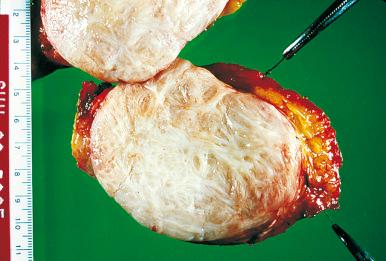
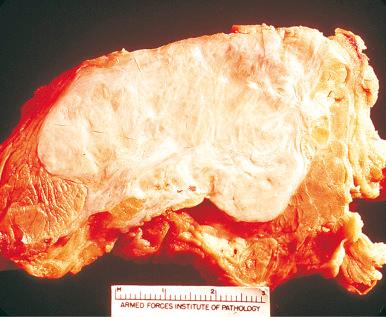
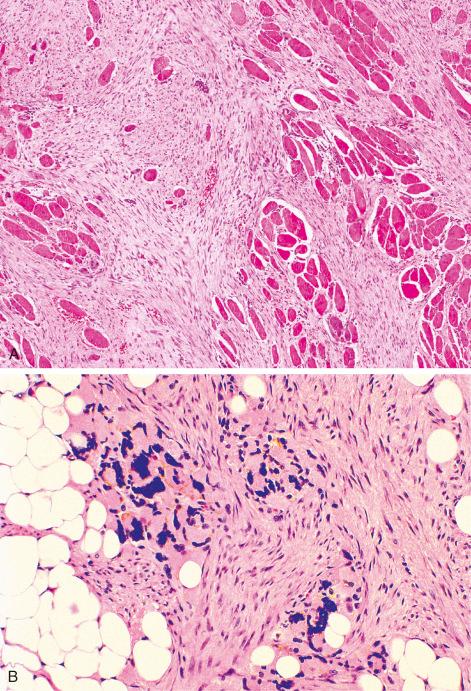
Although abdominal fibromatosis is indistinguishable grossly and microscopically from extraabdominal fibromatosis, it deserves separate consideration because of its characteristic location and its strong propensity to occur in women of childbearing age during or after pregnancy. The tumor arises from musculoaponeurotic structures of the abdominal wall, especially the rectus and internal oblique muscles and their fascial coverings.
Abdominal fibromatosis occurs in young, gravid, or parous women during gestation or, more frequently, during the first year following childbirth. Rare examples have been reported in children of both genders (especially boys) and adult men. Most tumors measure 3 to 10 cm in greatest dimension and, when arising in the rectus muscle or its fascia, usually remain at the site of origin and do not cross the abdominal midline.
Pelvic fibromatosis is a variant of intraabdominal fibromatosis, distinguished by its location in the iliac fossa and lower portion of the pelvis, where it manifests as a slowly growing palpable mass that is asymptomatic or causes only slight pain. Clinically, it is often mistaken for an ovarian neoplasm or a mesenteric cyst. Large tumors in this location may encroach on the urinary bladder, vagina, or rectum—or they may cause hydronephrosis or compress the iliac vessels. As with fibromatosis of the abdominal wall, the tumor arises from the aponeurosis or muscle tissue and occurs chiefly in young women 20 to 35 years of age; in most cases it is unrelated to gestation or childbirth. Grossly and microscopically, the tumor is indistinguishable from other forms of extraabdominal or abdominal fibromatosis and requires similar modes of therapy.
Fibromatosis is the most common primary tumor of the mesentery and accounts for approximately 8% of all fibromatoses. Although most cases are sporadic, some are associated with FAP/Gardner syndrome, trauma, or hyperestrogenic states. Most often, these tumors are located in the mesentery of the small bowel, but some originate from the ileocolic mesentery, gastrocolic ligament, omentum, or retroperitoneum ( Fig. 9.4 ).
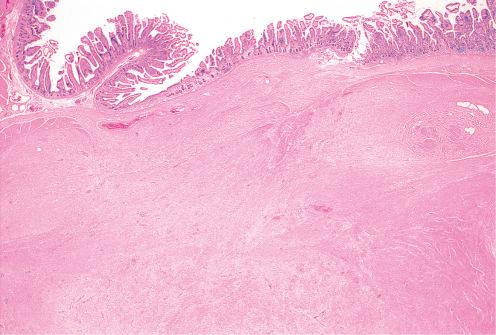
As with pelvic fibromatosis, most patients with mesenteric fibromatosis present with an asymptomatic abdominal mass, although some have mild abdominal pain. Less often, patients present with gastrointestinal bleeding or an acute abdomen secondary to bowel perforation. Occasionally, the tumor is found incidentally at laparotomy performed for some other reason, including patients undergoing a bowel resection for FAP.
Like many other neoplasms in the abdomen and retroperitoneum, most mesenteric fibromatoses are quite large at excision, with the majority measuring 10 cm or more. Many have an initial phase of rapid growth, and complications may be caused by compression of the ureter, development of a ureteral fistula, or compression of the small or large intestine, sometimes complicated by intestinal perforation.
In 1951, Gardner reported the familial occurrence of intestinal polyposis, osteomas, fibromas, and epidermal or sebaceous cysts; the term Gardner syndrome was coined by Smith in 1958. This syndrome is inherited as an autosomal dominant trait that occurs in approximately half the children of afflicted parents. It is more common in women than in men and is usually diagnosed in adults 25 to 35 years of age. Approximately 10% to 15% of patients with FAP/Gardner syndrome develop intraabdominal fibromatoses, an estimated 800-fold increased risk of developing such lesions.
In this setting, mesenteric or retroperitoneal fibromatosis usually has its onset 1 to 2 years after excision of the diseased portion of the intestinal tract, and these lesions are the most common cause of death in polyposis patients after colectomy is performed. In the classic study by Gurbuz et al., almost 70% of FAP patients who developed these lesions had abdominal surgery before the discovery of the fibromatosis. Compared with sporadic lesions, FAP-associated mesenteric fibromatoses arise in slightly younger patients (36 vs. 42 years, according to a large study in the Netherlands). FAP-related tumors also tend to be larger, multicentric, and intraabdominally situated. In a meta-analysis of 10 published studies, a positive family history of a desmoid tumor was the only factor predictive of development of this lesion in patients with FAP/Gardner syndrome. Durno et al. found that early colectomy, especially in female patients, significantly increased the risk of developing mesenteric fibromatosis.
Clinically, the fibromatosis may be asymptomatic or may cause mild abdominal pain or intestinal obstruction as a result of infiltrative growth into the wall of the small or large bowel. Histologically, the fibromatosis is virtually indistinguishable from those at other sites, and one cannot distinguish polyposis-related cases from sporadic cases by morphology alone.
Mesenteric fibromatoses with or without associated FAP/Gardner syndrome frequently recur, an observation that is not surprising given the central location and difficulty of complete surgical extirpation. There is significant morbidity associated with attempted resection, including ischemia, fistula formation, obstruction, and additional small bowel resections, which can result in short bowel syndrome and necessitate small bowel transplantation.
Gardner syndrome is a genetically determined, autosomal dominant disease caused by a germline abnormality of the APC gene on the long arm of chromosome 5. Tumors arising in the setting of FAP/Gardner syndrome harbor inactivating mutations of APC . Up to 85% of sporadic lesions harbor mutations in the gene that codes for β-catenin ( CTNNB1 ). Molecular assays for CTNNB1 mutations using paraffin-embedded tissue may be extremely useful in difficult-to-diagnose lesions, particularly distinguishing recurrent/residual fibromatosis from scar tissue. Mutations of this gene are not found in the spindle cell lesions likely to enter the diagnosis. CTNNB1 mutations result in the intranuclear accumulation of β-catenin protein, which can also be used as a diagnostic adjunct.
The morphologic features of deep fibromatoses are essentially identical in all anatomic locations, although some minor variation may be seen. The tumor is firm, cuts with a gritty sensation, and on cross section reveals a glistening white, coarsely trabeculated surface resembling scar tissue (see Figs. 9.1 and 9.2 ). As such, surgeons may have difficulty distinguishing recurrent fibromatosis from scar tissue related to a prior excision.
Histologically, the lesion is poorly circumscribed and infiltrates the surrounding tissue ( Fig. 9.3A ), where it may evoke a focal lymphocytic response and cause striking atrophy of the skeletal muscle ( Fig. 9.3B and C ). Mesenteric fibromatosis typically shows microscopic infiltration into the surrounding soft tissues, including the bowel wall (see Fig. 9.4 ).
Architecturally, the tumor grows in long, sweeping fascicles or graceful arcs ( Fig. 9.5 and 9.6 ) composed of elongated, spindle-shaped cells arranged in parallel fashion, a pattern sometimes likened to a school of fish ( Figs. 9.7 ). The uniform cells are separated from one another by a collagenous stroma with little or no cell-to-cell contact. The nuclei are small and pale staining with one to three pinpoint nucleoli ( Fig. 9.8A ). Nuclear atypia is not seen, although the presence of multinucleated giant cells on rare occasions may simulate the appearance of nuclear atypia ( Fig. 9.7C ). In cross section of fascicles of fibromatosis, the cells appear as widely spaced nuclear profiles ( Fig. 9.9 ). Mitotic figures are occasionally seen but rarely are numerous. There is no “cutoff” that distinguishes fibromatosis from fibrosarcoma , and this distinction instead is made on architectural and cytologic grounds. Fibromatoses typically contain thin-walled, dilated vessels, often with some perivascular edema, and recognition of this vascular pattern assists in the correct diagnosis of these tumors.
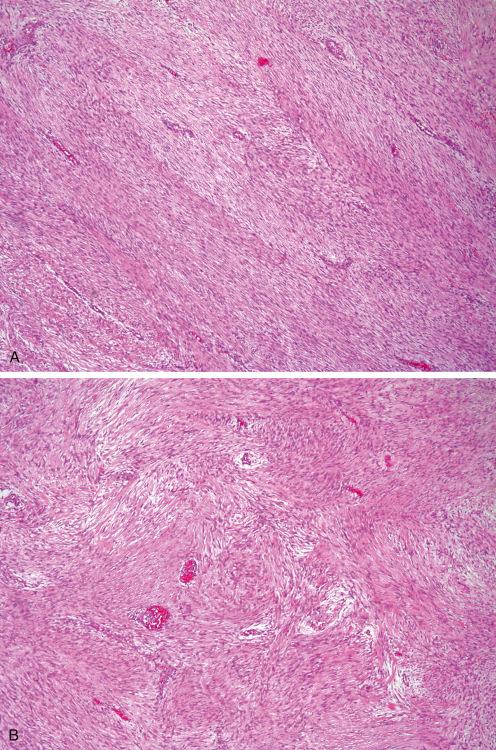
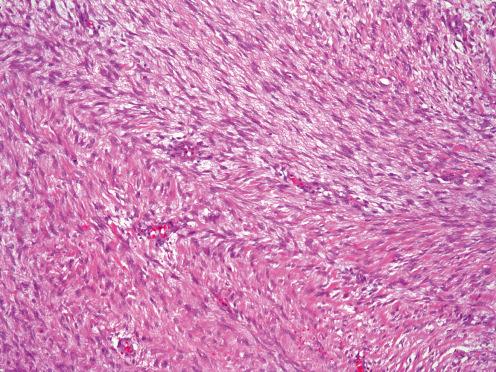
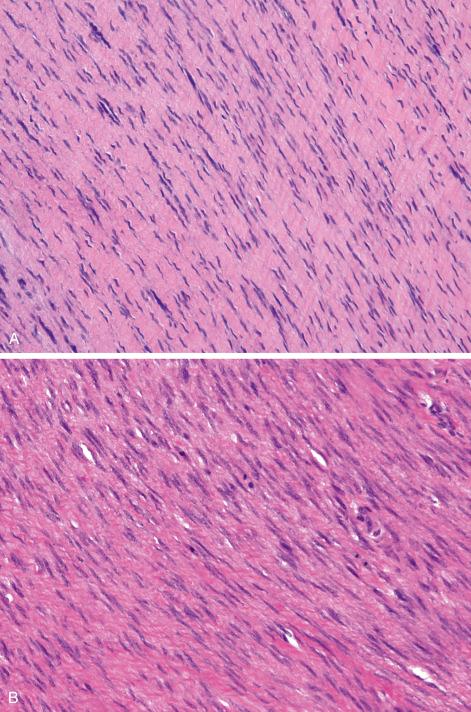

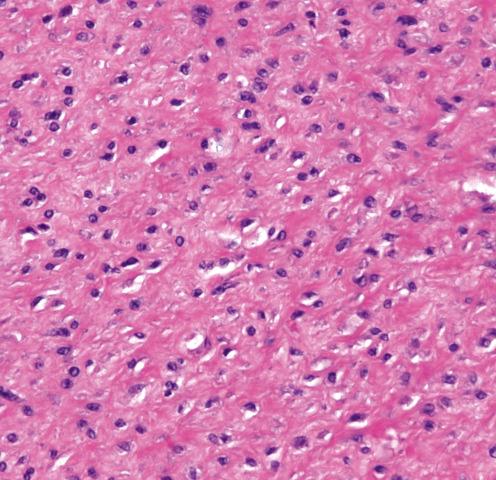
The foregoing describes the typical appearance of a fibromatosis, but these tumors can also vary from highly myxoid to very hyalinized ( Fig. 9.10A ). In myxoid lesions the cells are more widely spaced and more randomly arranged (Fig. 9.10B ). Hyalinization can be restricted to scattered dense keloidal bundles of collagen ( Fig. 9.10C ) or almost completely replace the tumor ( Fig. 9.10D and Fig. 9.11 ). In such cases, one should be alert to the presence of the characteristic ectatic vessels. In rare cases there is calcification or chondroid or osseous metaplasia, but this is never a prominent feature of the tumor. In assessing the morphologic features of fibromatoses of various sites, Zreik and Fritchie found the only significant difference to be that intraabdominal fibromatoses were more likely to have prominent keloidal collagen and a staghorn vascular pattern compared to extraabdominal and abdominal lesions. Gardner-associated fibromatoses tend to have a prominent myxoid matrix .
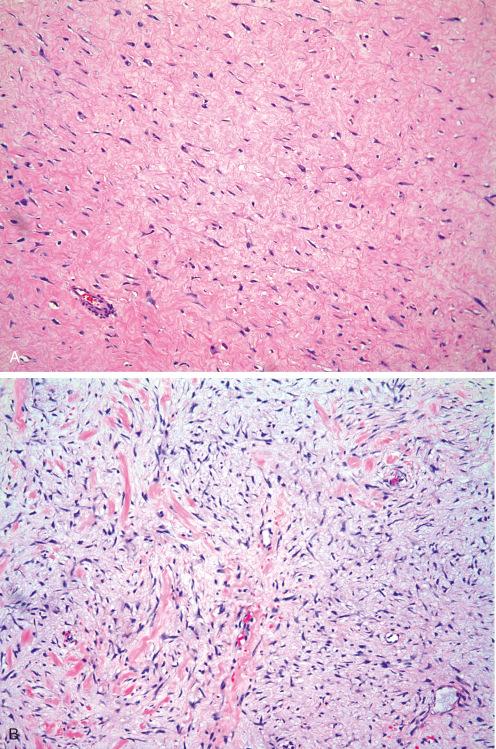
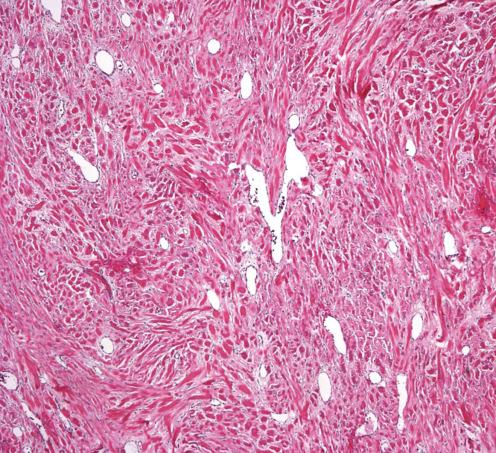
The IHC features of all subtypes of deep fibromatoses are similar. The spindle cells show variable staining for smooth muscle actin and muscle-specific actin, typically in a “tram-track” pattern, consistent with fibroblastic/myofibroblastic differentiation. Approximately 70% of fibromatoses show aberrant nuclear accumulation of β-catenin, although this finding is not perfectly specific for fibromatoses ( Fig. 9.8B ). In the Amary study, all deep fibromatoses stained for this antigen, but 72% of the lesions that can mimic fibromatosis also stained, indicating a lack of specificity. In our experience, this stain can be difficult to interpret because of background or nonspecific staining. More recently, lymphoid-enhancer factor 1 (LEF1) has been found to be consistently expressed in deep fibromatoses, but given its staining in scars, it has limited clinical utility.
Some studies have found consistent expression of CD117 (c-kit) in fibromatoses. For example, Yantiss et al. found that CD117 was expressed in 88% of gastrointestinal stromal tumors (as expected) but also in 75% of fibromatoses. Similarly, 6 of 10 mesenteric fibromatoses reported by Montgomery et al. expressed CD117. In our experience, mesenteric fibromatoses are consistently negative for CD117; reports to the contrary may be related to antibody choice or excessive epitope retrieval. DOG1 expression has not been reported in fibromatoses.
Because of the issues regarding the sensitivity and specificity of immunohistochemistry for the detection of β-catenin, there has been considerable interest in the development of other methods to test for this molecular alteration (see later).
The etiology of deep fibromatosis is almost certainly multifactorial because genetic, endocrine, and physical factors seem to play an important role in its pathogenesis. Features suggesting an underlying genetic basis are the occasional case in siblings and the occurrence of extraabdominal fibromatosis in patients with FAP. Mutations of the adenomatous polyposis coli (APC)/β-catenin pathway are identified in the majority of sporadic and FAP-associated deep fibromatoses.
Although clearly implicated in the development of abdominal fibromatosis, endocrine factors may also play a role in the development and growth of extraabdominal fibromatoses. Physical factors such as trauma or irradiation likely serve as a trigger mechanism, since examples of extraabdominal fibromatosis have been reported in the chest wall following trauma and reconstructive mammoplasty. An antecedent history of trauma has been reported in up to 16% to 28% of cases. Trauma likely plays a contributory role in the development of abdominal fibromatoses, as some tumors arise in the scars of radical nephrectomy sites, the insertion site of peritoneal dialysis catheters, and other abdominal surgery sites ( cicatricial fibromatosis ). Because most patients with abdominal fibromatosis have no history of gross injury to this region, minor and undetected trauma, such as minute muscle tears, may conceivably serve as a contributing etiologic factor that triggers the fibrous growth in a hormonally or genetically predisposed individual.
Genetic, endocrine, and physical factors also seem to play an important role in the development of intraabdominal fibromatoses. Some arise in the setting of FAP, often at the site of previous abdominal surgery. Endocrine factors are clearly implicated by the frequent occurrence of this tumor during or after pregnancy, and there are reports of these tumors regressing with menopause. The reported inhibitory effect of antiestrogenic agents, such as tamoxifen and raloxifene, also supports the role of hormonal factors in tumor development.
As a group, deep fibromatoses share the common feature of frequent local recurrence, although there are some differences between subtypes. Despite their bland microscopic appearance, extraabdominal fibromatoses frequently behave in a locally aggressive manner. Although incapable of metastasizing, there is a high rate of local recurrence. In 203 consecutive patients with extraabdominal fibromatoses treated with surgery over a 35-year period at a single referral center, Gronchi et al. reported a local recurrence rate of 76% at 10 years. Although tumor size was associated with risk of local recurrence, microscopically positive surgical margins did not predict recurrence rate. However, other studies have found the extent and adequacy of initial excision to be prognostically significant. Cates and Stricker found that a positive or close (<1 mm) resection margin was an independent prognostic factor for local recurrence in a multivariate Cox regression model accounting for patient age and anatomic site. They also found that the probability of documenting a positive margin increased with the number of tissue sections submitted for assessing margin status and recommended multiple targeted tissue sections for accurate assessment of surgical resection margins for these tumors.
Spontaneous regression has been observed in sporadic cases, particularly in menarchal and menopausal patients. Thus, some have advocated a more conservative watch-and-wait approach before initiating surgery. In the Burtenshaw study, of the 58 patients treated with observation only, 93% experienced either spontaneous regression or stable disease with median follow-up of 38 months.
Like their extraabdominal counterparts, abdominal lesions also have a propensity to recur locally, although the rate of local recurrence (15%–30%) is slightly lower than that of extraabdominal lesions (35%–65%). In most cases, the lesions recur within the first 2 years after the initial excision or in connection with subsequent gestations or deliveries. Multiple recurrences are not uncommon.
Intraabdominal lesions also have a propensity for local recurrence, although data on the recurrence rates differ greatly. In the Burke study, 23% of tumors recurred, although there was a striking difference in recurrence rates between patients with (90%) and without (12%) FAP/Gardner syndrome. In fact, none of the patients with sporadic mesenteric fibromatosis had more than one recurrence, and none of those patients died as a direct result of their tumor. In contrast, most of the patients with FAP/Gardner syndrome had more than one recurrence, and four patients died of their tumor.
A number of different modalities have been used in the treatment of deep fibromatoses, including surgery, chemotherapy, radiation therapy, and even clinical observation. The optimum treatment for any given patient depends on a number of tumor and patient-related factors, including tumor size, tumor site, the patient’s medical status, and comorbidities. As previously mentioned, observation is an acceptable mode of therapy for asymptomatic tumors. However, for symptomatic tumors, some form of treatment is indicated, particularly if vital structures are at risk. Surgical excision with negative microscopic margins is one of the mainstays of therapy, but local recurrences still follow apparently complete surgical excision. The goal of surgery is complete removal while preserving function and minimizing morbidity.
In situations where a wide local excision cannot be performed, postoperative radiation therapy is often used. Gluck et al. found equivalent local control for patients treated with surgery, radiation, or both. In a meta-analysis assessing the influence of surgical margins and adjuvant radiotherapy on local recurrence of these tumors, Janssen et al. found that adjuvant radiotherapy after surgery with negative margins had no significant effect on the risk of local recurrence. However, adjuvant radiotherapy after incomplete surgical resection improved recurrence rates in patients with both primary and recurrent deep fibromatoses.
Imatinib mesylate (Gleevec) therapy has been attempted in the salvage setting in patients with deep fibromatoses. Other tyrosine kinase inhibitors such as sorafenib and nilotinib may be useful following treatment failure with imatinib. Cytotoxic and noncytotoxic drug therapy has also been attempted for the treatment of these tumors. Chemotherapeutic agents and nonsteroidal antiinflammatory prostaglandin-inhibiting drugs, such as sulindac and indomethacin, have been reported to cause stabilization or regression of both primary and recurrent tumors. The efficacy of antiestrogenic therapy, including tamoxifen, progesterone, or the luteinizing hormone–releasing hormone analogue goserelin acetate, is not fully established but appears to be promising.
Fibromatosis most closely resembles adult-type fibrosarcoma on the one extreme and benign fibroblastic processes on the other. Adult-type fibrosarcoma is more uniformly cellular, and the cells are arranged in a more consistent, sweeping fascicular (herringbone) growth pattern. Unlike fibromatosis, the cells are often overlapping and separated by less collagen. The nuclei are more hyperchromatic and atypical and have more prominent nucleoli than those found in fibromatosis. Although it is important to remember that there can be considerable overlap in levels of mitotic activity between fibromatosis and adult-type fibrosarcoma, high mitotic counts (>1 mitotic figure per 10 high-power fields [hpf]) throughout a tumor should at least arouse some suspicion of fibrosarcoma. A small biopsy specimen may lead to a misdiagnosis because some examples of adult-type fibrosarcoma have areas that are indistinguishable from fibromatosis, and vice versa.
Fibromatosis can also be difficult to distinguish from reactive fibroblastic/myofibroblastic proliferations following injuries such as trauma, minor muscle tear, or intramuscular injection. Cytologically, these reactive proliferations are composed of cells that are essentially indistinguishable from those found in fibromatosis. The low-magnification appearance is much more useful for distinguishing these entities, because reactive processes have a more variable growth pattern and frequently have focal hemorrhage or hemosiderin deposition, often situated along vascular structures. In some cases, iron stains are useful for highlighting hemosiderin that is difficult to identify on hematoxylin-eosin–stained sections. In addition, an infiltrative growth pattern is much more characteristic of fibromatosis. β-Catenin immunohistochemistry (IHC) may be of some value in this distinction, although it is not a perfect ancillary test.
Desmoplastic fibroma of bone is histologically indistinguishable from fibromatosis, especially when it presents as a soft tissue mass after breaking through the thinned or expanded cortex of the involved bone. This lesion predominates in the metaphyseal or diaphyseal portions of long bones (e.g., femur) or in the jaw, and radiographic studies are essential for distinguishing between these lesions. Interestingly, desmoplastic fibroma of bone lacks β-catenin mutations, and ancillary testing for this genetic event may be helpful in select cases.
Confusion with myxoma is possible, particularly if only a small biopsy is available for examination. Myxoma is usually paucicellular, with the cells separated by abundant myxoid matrix. In contrast, fibromatosis always displays a greater degree of cellularity and more interstitial collagen than myxoma.
In the breast, fibromatosis should be distinguished from metaplastic carcinoma, malignant phyllodes tumor, and benign processes such as nodular fasciitis and keloid. In general, IHC for keratins, in particular high-molecular-weight keratins, helps distinguish fibromatosis from metaplastic carcinoma . Metaplastic carcinomas also tend to show greater nuclear atypia and often contain small foci of cellular clustering (“proliferation centers”), a helpful morphologic feature. Phyllodes tumors can usually be identified with extensive sampling to reveal foci of epithelial proliferation. Identification of MED12 mutations may also be helpful in the diagnosis of phyllodes tumors, although this test is not yet widely available.
The differential diagnosis for intraabdominal fibromatosis also includes sclerosing mesenteritis , a lesion also sometimes referred to as mesenteric panniculitis and mesenteric lipodystrophy . As with mesenteric fibromatosis, sclerosing mesenteritis typically involves the small bowel mesentery and presents as a large solitary mass, although multiple lesions or diffuse mesenteric thickening may also be seen. Histologically, sclerosing mesenteritis is composed of variable amounts of fibrosis, chronic inflammation, and fat necrosis. Any of these three components may predominate in a given lesion. In difficult cases, IHC staining for β-catenin can be useful because mesenteric fibromatosis consistently shows strong nuclear β-catenin staining, whereas sclerosing mesenteritis does not express this antigen ( Table 9.1 ). This immunostain may, however, be difficult to interpret.
| GIST | Sclerosing Mesenteritis | Mesenteric Fibromatosis | |
|---|---|---|---|
| CD117 | + | − | − |
| DOG1 | + | − | − |
| β-catenin | − | − | + |
| CD34 | + | − | − |
| SMA | ± | + | ± |
| Desmin | − | − | Rare |
| S-100 protein | − | − | − |
Inflammatory myofibroblastic tumor (IMT) of the mesentery and retroperitoneum is also a diagnostic consideration, but this lesion is more cellular, has more pronounced cytologic atypia, and is more inflamed than mesenteric fibromatosis. Moreover, many (but not all) cases of IMT express anaplastic lymphoma kinase (ALK)-1 protein, which is not found in mesenteric fibromatosis.
Also included in the differential diagnosis is idiopathic retroperitoneal fibrosis , also known as Ormond disease . This is an uncommon fibroinflammatory process characterized by diffuse or localized fibroblastic proliferation and a chronic lymphoplasmacytic infiltrate in the retroperitoneum causing compression or obstruction of the ureters, aorta, or other vascular structures. It is more common in men, and most patients present in the fifth or sixth decade of life. Most patients present with vague, nonspecific abdominal symptoms, but some have weight loss, nausea and vomiting, anorexia, or fever. Although many cases are idiopathic, some are clearly drug related (methysergide, pergolide), and up to 50% of cases are immunoglobulin G4 (IgG4) related (see later). Grossly, idiopathic retroperitoneal fibrosis is dense, white, and plaquelike, usually arising at or just below the aortic bifurcation. With progression, it surrounds the aorta and inferior vena cava and spreads through the retroperitoneum in a perivascular distribution. Histologically, broad anastomosing bands of hyalinized collagen are associated with a fibroblastic proliferation and lymphoplasmacytic infiltrate with occasional germinal centers. The aorta, which is surrounded by the proliferation, usually shows severe atherosclerosis, with protrusion of atherosclerotic debris through the media into the adventitia with intramural chronic inflammation. In some cases a large number of IgG4-immunoreactive cells are found within the infiltrate, suggesting (in up to 50% of cases) that it is part of a larger group of IgG4-related sclerosing diseases. Immunosuppressive agents are effective in the treatment of this condition.
Distinguishing mesenteric fibromatosis from mesenteric gastrointestinal stromal tumor (GIST) can be difficult in some cases. Distinguishing between these lesions is of clinical significance because of their vastly different therapeutic and prognostic implications. In a study of 25 cases of mesenteric fibromatosis, Rodriguez et al. found that GIST was by far the most common misdiagnosis, occurring in 52% of the cases. The histologic features of GIST are heterogeneous and can range from bland spindle cell tumors to highly cellular and overtly malignant epithelioid tumors. The confusion between these entities is compounded by and in large part may have arisen because of reports of KIT (CD117) expression in mesenteric fibromatosis. Regardless of the immunophenotypic findings, mesenteric fibromatosis is sufficiently distinct from GIST on a morphologic basis that IHC may not be necessary for diagnostic purposes in most cases ( Table 9.2 ).
| Feature | Mesenteric Fibromatosis | GIST |
|---|---|---|
| Cell shape | Wavy, spindled | Spindled and/or epithelioid |
| Atypia | None | Variable |
| Growth pattern | Uniform, fascicular | Organoid, fascicles (variable) |
| Cellularity | Low to moderate | Moderate to high |
| Blood vessels | Regular, dilated, and thin-walled | Hyalinized |
| Keloidal collagen | Frequent | Absent |
| Skeinoid fibers | Absent | May be present |
| Necrosis | Absent | May be present |
| Margins | Infiltrative | Often pushing |
| CD117 | − | + |
| DOG1 | − | + |
| CD34 | − | + |
| β-Catenin | + (nuclear) | − |
Fibrosarcoma in newborns, infants, and small children bears some resemblance to adult-type fibrosarcoma but is considered a separate entity because of its markedly different clinical behavior as well as its distinctive molecular features.
Congenital/infantile fibrosarcoma is relatively rare. The first detailed clinicopathologic study of this entity was reported by Stout in 1962, who reviewed 31 cases from the literature and added 23 new cases of juvenile fibrosarcoma, 11 of which developed during the first 5 years of life and 4 of which were present at birth. Even in this early description, he suggested that fibrosarcomas arising in this group of patients were more indolent than their adult counterparts. Although several subsequent smaller series of congenital/infantile fibrosarcoma were reported, the Chung and Enzinger series of 53 cases in 1976 provided conclusive evidence supporting this tumor as a distinct entity. Similar conclusions were reached by Soule and Pritchard in 110 cases, including 70 previously published cases and 40 new cases from the Mayo Clinic.
The principal manifestation of the disease is a nontender, painless swelling or mass that ranges from 1 to 20 cm. Up to one-third of the tumors are present at birth; in most cases the mass becomes evident during the first year of life. In the Armed Forces Institute of Pathology (AFIP) series, 20 of 53 tumors (38%) were present at birth, and 27 (51%) were noted before age 3 months. Similarly, 40 of 110 cases (36%) reported by Soule and Pritchard were congenital. Males are affected slightly more often than females. The principal sites of involvement are the extremities, especially the regions of the foot, ankle, and lower leg and the hand, wrist, and forearm. The next most common sites of involvement are the trunk and head and neck regions, although these tumors have also been reported in virtually every anatomic site.
Radiographic examination may show, in addition to a soft tissue mass, cortical thickening, bending deformities, and rarely extensive destruction of the underlying bone ( Fig. 9.12 ). Both MRI and ultrasound are useful in the evaluation of these tumors, including the detection of congenital tumors in utero. Interestingly, some newborns with this tumor show evidence of hypercalcemia, presumably caused by the production of parathormone-related protein.
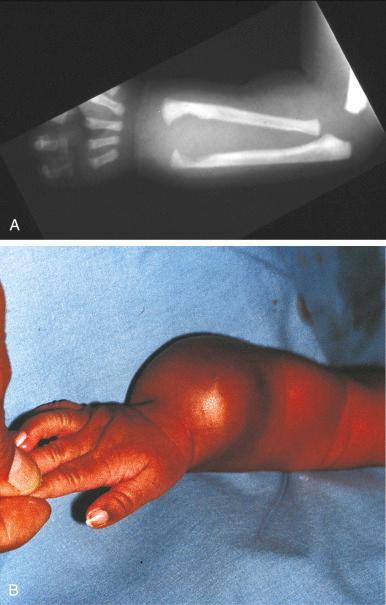
The tumors vary considerably in size. Some are only a few centimeters when first detected, whereas others are extremely large and may replace the entire distal portion of the involved limb. Some patients present with a large exophytic mass that ulcerates the overlying skin. Most are poorly circumscribed, fusiform or disk shaped, and have a gray-white or pale-pink cut surface. Large tumors may be greatly distorted by central necrosis or hemorrhage ( Fig. 9.13 ), whereas others show extensive myxoid or cystic change.
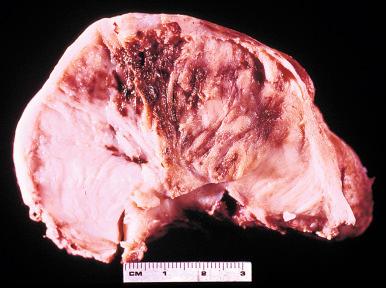
Histologically, most examples closely resemble their adult counterparts and are composed of sheets of solidly packed, spindle-shaped cells that are relatively uniform in appearance and arranged in bundles or fascicles, imparting a herringbone appearance. The cells show minimal nuclear pleomorphism and are mitotically active, but their numbers vary from area to area in the same tumor. Tumors with abundant collagen tend to be more fasciculated and often approach the appearance of an adult-type fibrosarcoma (sometimes referred to as the desmoplastic type). Tumors with minimal amounts of collagen, on the other hand, show a lesser degree of cellular polarity and consist of small, more rounded, immature-appearing cells with only focal evidence of fibroblastic differentiation ( medullary type) ( Figs. 9.14 to 9.16 ). Bizarre cells and multinucleated giant cells are rare. Scattered chronic inflammatory cells, particularly lymphocytes, are another common, sometimes striking feature that distinguishes infantile from adult fibrosarcoma. A hemangiopericytoma-like vascular pattern may be prominent ( Fig. 9.17 ).
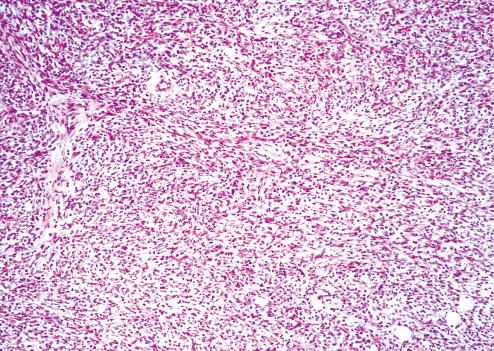

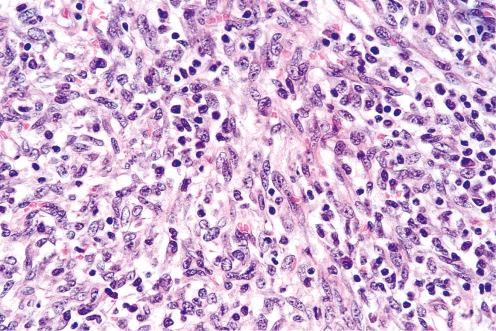
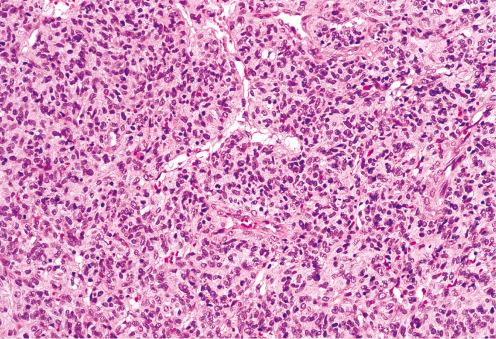
On IHC the spindle cells of congenital/infantile fibrosarcoma stain variably for muscle markers, including muscle-specific actin (MSA), smooth muscle actin (SMA), and h-caldesmon. The more primitive-appearing ovoid cells tend not to express these muscle markers. As discussed later, NTRK3 aberrations are characteristic of this tumor, and a Pan-Trk antibody was recently found to correlate well with the presence of NTRK3 fusions, suggesting a clinical role for this IHC marker.
Numerous studies have noted a nonrandom gain of chromosomes 11, 20, 17, and 8 (in descending order of frequency). Using fluorescence in situ hybridization (FISH), Schofield et al. found gains of these chromosomes (in various combinations) in 11 of 12 infantile fibrosarcomas in patients younger than 2 years. In contrast, alterations of these chromosomes were not found in four fibrosarcomas in patients age 6 to 17 years. Interestingly, one of three cases of “cellular fibromatosis” also showed these cytogenetic abnormalities, suggesting that “these two entities constitute a spectrum and that their distinction may not be clear-cut.”
Most congenital/infantile fibrosarcomas and cellular mesoblastic nephroma have the same diagnostic chromosomal translocation: t(12;15)(p13;q25). This translocation results in a fusion of the ETV6 gene on chromosome 12 with the neurotrophin-3 receptor NTRK3 (also known as TRKC ) gene on chromosome 15. Although this translocation is difficult to detect by conventional cytogenetics, it can be readily demonstrated by reverse-transcriptase polymerase chain reaction (RT-PCR) or FISH. Given the similar histologic and cytogenetic findings in congenital/infantile fibrosarcoma and cellular mesoblastic nephroma, these two lesions may be histogenetically related entities arising in soft tissue and renal locations, respectively. Interestingly, a number of other tumors, including secretory breast carcinoma, rare subtypes of acute myeloid leukemia, and mammary-type secretory carcinoma of skin and salivary glands, also harbor this same translocation. Rare cases of congenital/infantile fibrosarcoma with an EML4-NTRK3 fusion or an LMNA-NTRK1 fusion have also been reported. Recently, Kao et al. identified several spindle cell sarcomas with histologic features overlapping congenital/infantile fibrosarcoma with BRAF mutations, but the exact nature of these tumors and their relationship to congenital/infantile fibrosarcoma is somewhat unclear.
The microscopic picture may be confused with that of other pediatric mesenchymal neoplasms, but in most cases the uniformity of the spindle-shaped tumor cells, the solid growth pattern, the fascicular arrangement, and the lack of any other form of cellular differentiation permit a reliable diagnosis.
Spindle cell rhabdomyosarcoma may be difficult to distinguish from congenital/infantile fibrosarcoma. This tumor is most often encountered in the paratesticular region and the head and neck, but it may also be present at other sites, including the extremities. Histologically, it is composed of uniform spindled cells often with eosinophilic fibrillar cytoplasm and elongated hyperchromatic nuclei separated by abundant, partly hyalinized collagen. On IHC, this tumor characteristically expresses desmin and myogenin, which are absent in congenital/infantile fibrosarcoma.
In 1993, Lundgren et al. described three cases of infantile rhabdomyofibrosarcoma , each of which was initially diagnosed as congenital/infantile fibrosarcoma. This tumor, which was observed in children age 3 months to 3 years, has features that overlap spindle cell rhabdomyosarcoma and desmoplastic portions of congenital/infantile fibrosarcoma. On IHC the cells express SMA and desmin; focal MyoD1 expression is also present as well. Two of the three cases reported by Lundgren et al. showed monosomy of chromosome 19 and 22, among other abnormalities; a case reported by Miki et al. showed der(2) t(2;11)(q37;q13). Two of the patients from the original report developed metastases and died within 2 years of the primary operation; the third patient was alive with a local recurrence. The exact nature of this tumor is still not clear. It may represent an intermediate form between a congenital/infantile fibrosarcoma and a spindle cell rhabdomyosarcoma. Also, some tumors reported as congenital/infantile fibrosarcoma that have metastasized and followed a fatal course may actually be examples of this rare entity.
Primitive myxoid mesenchymal tumor of infancy is another rare tumor composed of primitive cells deposited in an abundant myxoid stroma that in some cases can resemble congenital/infantile fibrosarcoma. Recently, this tumor has been found to be characterized by recurrent BCOR internal tandem duplications; expression of BCOR and BCL6 allows for its separation from congenital/infantile fibrosarcoma.
Fat-poor, cellular forms of lipofibromatosis may also mimic infantile fibrosarcoma ( Table 9.3 ). Some authors have reported cases in which the primary tumor had the appearance and growth pattern of lipofibromatosis, whereas the recurrent tumor showed greater cellularity and was virtually indistinguishable from fibrosarcoma. On the other hand, tumors with a fibrosarcoma-like appearance in the primary neoplasm and a lipofibromatosis-like appearance in the recurrence have also been observed. Further, a congenital/infantile fibrosarcoma with a surrounding lipofibromatosis-like component has also been reported. Detection of the ETV6-NTRK3 fusion allows for distinction between these lesions.
| Feature | Lipofibromatosis | Congenital/Infantile Fibrosarcoma |
|---|---|---|
| Cellularity | Variable | Moderate to high |
| Herringbone pattern | Absent | Usually present |
| Fat | Focally present | Absent |
| Mitotic figures | Rare | Few to many |
| Hemorrhage | Absent | Often present |
| Necrosis | Absent | Often present |
| t(12;15)(p13;q25) | Absent | Present |
Compared with adult-type fibrosarcoma, the clinical course of congenital/infantile fibrosarcoma is favorable. Of the 48 patients with follow-up in the Chung and Enzinger study, only eight (17%) developed one or more local recurrences 6 weeks to 10 years after the initial excision. Only four (8%) patients died of metastatic disease, and one patient was living 6.5 years after a lobectomy for a metastatic tumor. The 5-year survival rate in this series was 84%. The recurrent and nonrecurrent groups showed no demonstrable differences in regard to tumor site, age at onset, or size of the tumor. However, the initial therapy was more radical for the tumors that neither recurred nor metastasized. Most studies have found that cellularity, mitotic counts, and extent of tumor necrosis do not correlate well with clinical behavior. Some have found that tumors in the axial skeleton behaved more aggressively than those found peripherally. There are reports of incompletely excised infantile fibrosarcomas that have not recurred or metastasized after several years, as well as sporadic reports of spontaneous regression.
Despite rapid growth and a high degree of cellularity, most congenital/infantile fibrosarcomas are cured by wide local excision. A number of reports have indicated that preoperative chemotherapy is useful for decreasing tumor bulk, enabling a more conservative surgical approach. There are also reports of success with postoperative chemotherapy and with chemotherapy alone as a mode of treatment for inoperable tumors. In view of the generally favorable clinical course, it appears that adjuvant radiotherapy and chemotherapy should be reserved for congenital/infantile fibrosarcomas that are unresectable or have recurred or metastasized.
Inflammatory myofibroblastic tumor (IMT) is a histologically distinctive lesion that occurs primarily in the viscera and soft tissue of children and young adults. It is considered a tumor of borderline malignancy because of its tendency to recur locally (at least at certain sites) and its ability rarely to metastasize. Although original descriptions of this lesion focused on its occurrence in the lung, inflammatory myofibroblastic tumor has been described in virtually every anatomic location and under many appellations, including plasma cell granuloma, plasma cell pseudotumor, inflammatory myofibrohistiocytic proliferation, omental-mesenteric myxoid hamartoma, inflammatory fibrosarcoma, and most commonly, “inflammatory pseudotumor.” The term inflammatory myofibroblastic tumor is preferred because inflammatory pseudotumor has been applied to diverse entities, including pseudosarcomatous myofibroblastic proliferations of the lower genitourinary tract, infectious lesions (including those secondary to Mycobacterium avium-intracellulare complex), Epstein-Barr virus–associated follicular dendritic cell tumors usually found in the liver or spleen, and reactive inflammatory pseudotumors of lymph nodes ( Fig. 9.18 ). This discussion focuses on extrapulmonary IMTs.

IMTs have been reported in virtually every anatomic site. The most common sites of extrapulmonary IMT are the mesentery and omentum. In a seminal study by Coffin et al., 36 of 84 (43%) extrapulmonary lesions arose at these sites. Unusual sites of involvement include the thyroid, central nervous system, uterus, and sites attached to various parts of the gastrointestinal (GI) tract. Although the age range is broad, extrapulmonary IMTs show a predilection for children, with a mean age of approximately 10 years. Females are affected slightly more often than males.
Presenting symptoms depend on the site of primary tumor involvement. Patients with intraabdominal tumors typically complain of abdominal pain or an abdominal mass with increased girth, occasionally with signs and symptoms of GI obstruction. Some patients have prominent systemic manifestations, including fever, night sweats, weight loss, and malaise, possibly related to the secretion of cytokines, including interleukin (IL)-6. Laboratory abnormalities are present in a small number of patients and include an elevated erythrocyte sedimentation rate, anemia, thrombocytosis, and hypergammaglobulinemia, which often resolve when the lesion is excised.
Grossly, most IMTs are lobular, multinodular, or bosselated with a hard or rubbery cut surface that appears white, gray, tan-yellow, or red ( Fig. 9.19 ). Those with calcifications cut with a gritty sensation. Although most are solitary tumors, multiple nodules generally restricted to the same anatomic location are found in almost one-third of cases. The tumors range in size from 2 to 20 cm, but most are 5 to 10 cm.
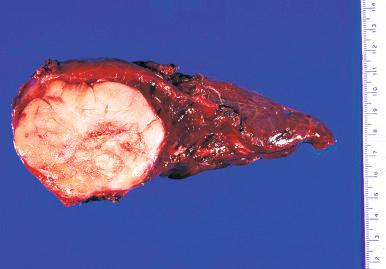
A variety of histologic patterns may be seen, and different patterns may be found in the same tumor. Some IMTs are composed predominantly of cytologically bland spindle- or stellate-shaped cells loosely arranged in a myxoid or hyaline stroma with scattered inflammatory cells, somewhat resembling nodular fasciitis. Others are composed of a compact proliferation of spindle-shaped cells arranged in a storiform or fascicular growth pattern ( Figs. 9.20 to 9.24 ). In these foci, the nuclei tend to be elongated but lack significant hyperchromasia or cytologic atypia. Mitotic figures are variable but not atypical. These foci are usually associated with a prominent lymphoplasmacytic infiltrate, occasionally with formation of germinal centers. Other foci may be sparsely cellular, with cytologically bland cells deposited in a sclerotic stroma resembling a scar. Lymphocytes and plasma cells are often seen in these foci, and small punctate areas of calcification or metaplastic bone may be observed.
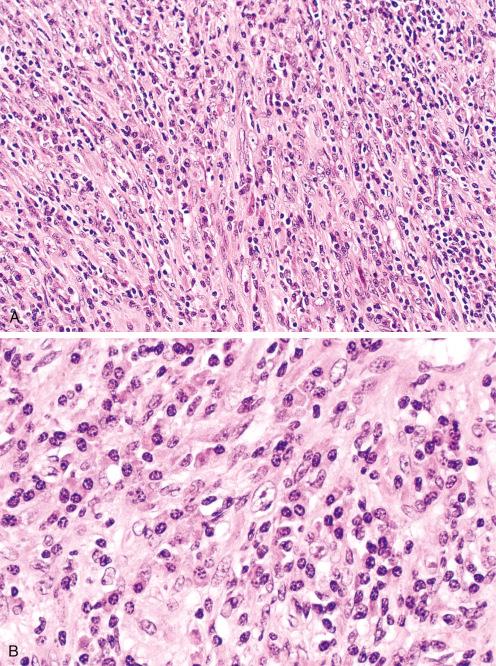
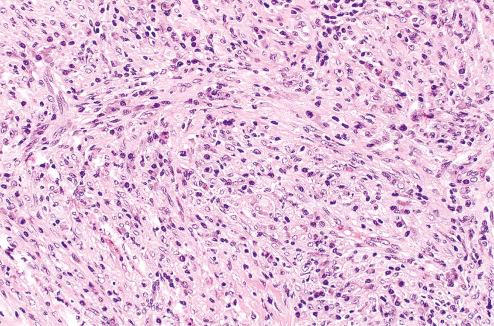
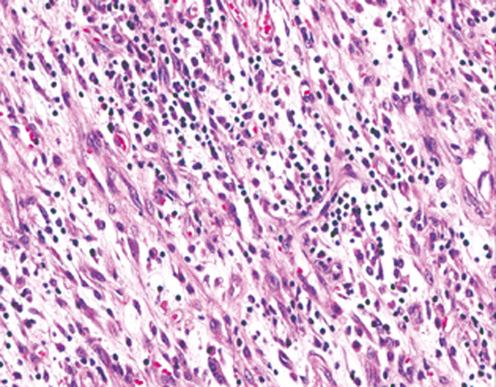
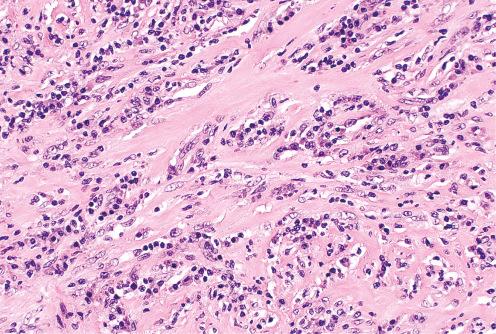
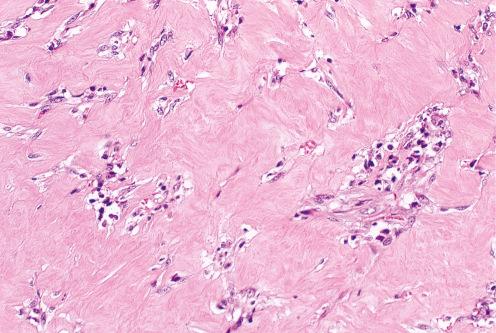
In some lesions, there is pronounced cytologic atypia, with cells containing large nuclei and distinct nucleoli ( Figs. 9.25 to 9.27 ). Some tumors have large histiocytoid cells resembling ganglion cells or Reed-Sternberg cells. In 2011, Mariño-Enriquez et al. described 11 IMTs arising within the abdomen (mesentery or omentum) with prominent epithelioid morphology, a unique pattern of nuclear membrane or perinuclear ALK immunoreactivity ( Fig. 9.28A ) and aggressive clinical behavior, coining the term epithelioid inflammatory myofibroblastic sarcoma. Subsequently, other similar-appearing cases have been reported in the literature.
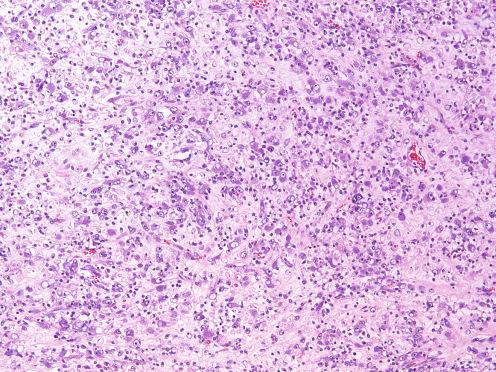
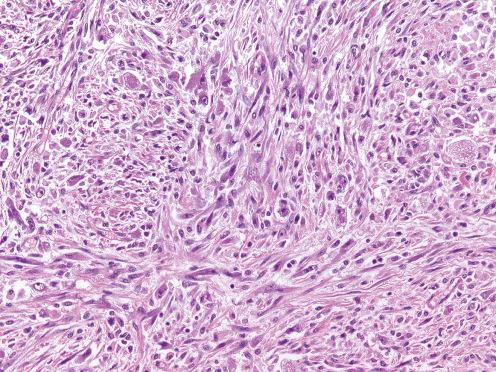
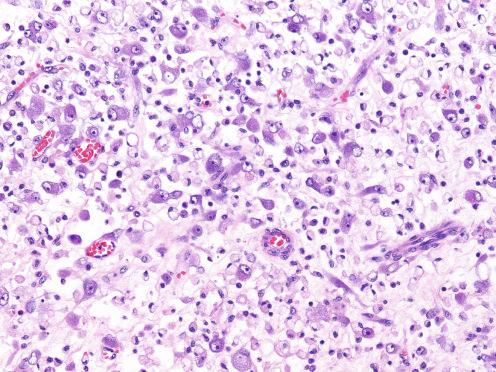
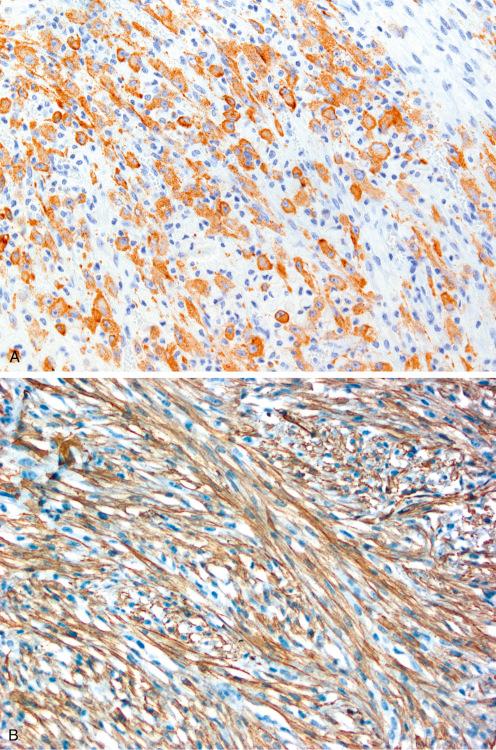
The tumor cells variably express myoid markers, including SMA ( Fig. 9.28B ), MSA, and desmin. Meis and Enzinger found that SMA and MSA were present in 90% and 83% of cases, respectively. In contrast, there was equivocal desmin staining in only 1 of 11 cases (9%). Coffin et al. found staining for SMA, MSA, and desmin in 92%, 89%, and 69%, respectively. Focal keratin immunoreactivity was noted in 36% and 77% of cases in the studies by Coffin and Meis and Enzinger, respectively.
A high percentage of IMTs are associated with ALK mutations, and as such, many are also immunoreactive for ALK. A wide range of ALK positivity is reported, ranging from 36% to 60% of cases. Thus this marker lacks sensitivity, and there is an imperfect correlation with ALK mutations. Evidence suggests that different fusion partners result in different patterns of ALK immunoreactivity. For example, Chen and Lee described an IMT with a RANBP2-ALK fusion that was associated with round cell transformation and an unusual pattern of nuclear membrane ALK expression. Similarly, Mariño-Enriquez reported epithelioid inflammatory myofibroblastic sarcomas with RANBP2-ALK fusions that also showed nuclear membrane staining for ALK, although some showed perinuclear ALK staining. Others have also noted this correlation between a fusion partner (in this case, RANBP2 ) and pattern of ALK staining. Diffuse cytoplasmic staining for ALK is typically seen with TPM3 , TPM4 , ATIC , SEC31L1 , and CARS fusions, whereas granular cytoplasmic staining is seen with a CLTC fusion.
Become a Clinical Tree membership for Full access and enjoy Unlimited articles
If you are a member. Log in here